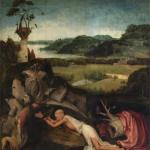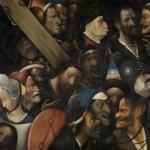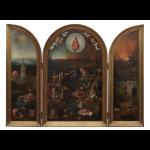This archived website 'Flemish primitives' is temporarily not being updated. Certain functionality (e.g. specific searches in the collection) may no longer be available. News updates about the Flemish primitives will appear on vlaamsekunstcollectie.be. Questions about this website? Please contact us at info@vlaamsekunstcollectie.be.
Jheronimus Bosch
Jheronimus Bosch was born around 1450 to a family of painters. His grandparents came from the german town of Aachen, but migrated westwards, direction of Nijmegen in the Northern Low Countries. Bosch's father was observed being in 's Hertogenbosch. It is suspected that Bosch was born there in a family of five children, or which four of them took up the painter's brush. He was a member of the Brotherhood of Our Blessed Lady.
Bosch developed a highly recongisable, idosyncratic painting style. Bosch cannot be placed stylistically in line with the Primitives, in that he proceded too self-styled with his work. His ouevre, however, indeed falls within the established limits of time and place. Primarily, he enjoys prestige for his fantastic and nearly diabolical works with all sorts of beings that in general have a moralising meaning. A typical example is the Triptych of the Grail, better known as The Garden of Earthly Delights Triptych in the Prado Museum in Madrid. Bosch shows what the consequences of sin and debauchery are.
Circa 1450
Bosch was presumably born in ´s Hertogenbosch.
1474
Bosch's name is recorded for the first time in documents that have been preserved.
1480-1481
Bosch is mentioned as a painter for the first time.
June 1481
He marries Aleyt Goyart van den Meervenne, a daughter of a moneyed member from the local patriciate.
1486
Bosch becomes a member of the Brotherhood of Our Blessed Lady. In 1488 he is sworn in as member, which indicates a necessary status. In 1493, 1503-04, 1508-09 and 1511-12 he produces five small works for the fraternity.
1493, 1503-1504, 1508-1509, 1511-1512
The artist produces five small works for the fraternity.
1488
Bosch is the owner of a house with land in the Schilderstraetken in ´s Hertogenbosch, inherited by his wife.
1474-1498
Fourteen documents are found for this period with regards to financial transactions for Bosch and his wife, among which is the sale of his wife's real estate.
1500
Bosch is meanwhile wealthy enough that he no longer has to paint. Tax records for the years 1502-03 and 1511-12 shows that Bosch belonged to the ten wealthiest citizens of ´s Hertogenbosch.
1502-03 and 1511-12
Tax records for these years show that Bosch belonged to the ten wealthiest citizens of ´s Hertogenbosch.
1516
Jheronimus Bosch dies.
Vanessa Paumen and Matthias Depoorter












